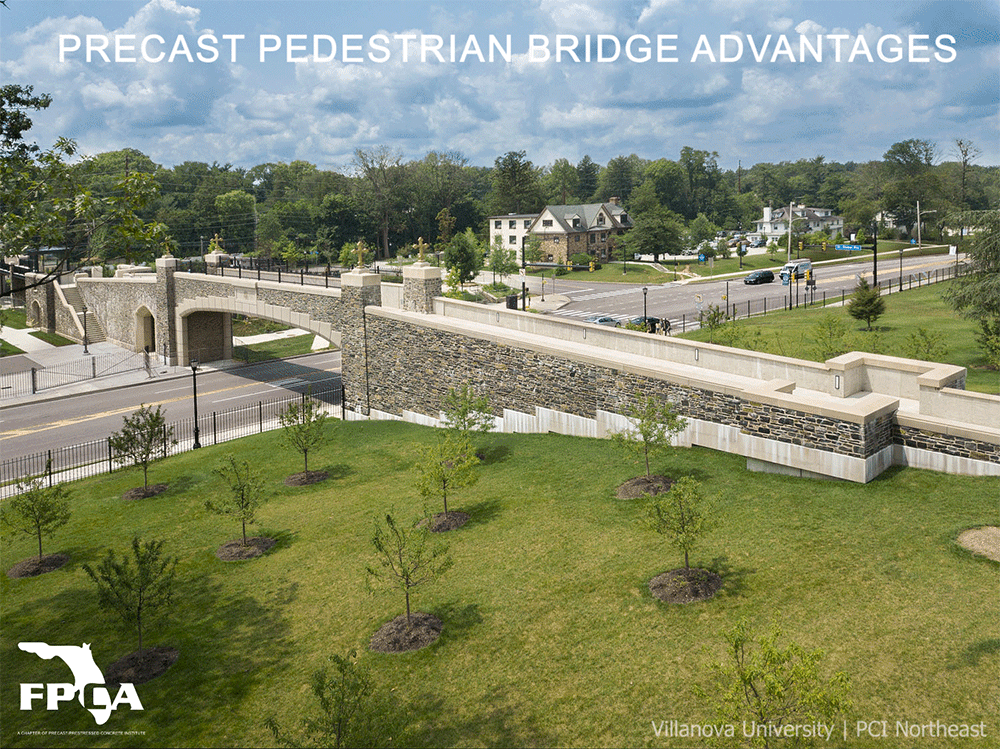Pedestrian bridges are more commonly used in places like cities and parks to help make crossings safer for the communities using them. A pedestrian bridge can be made from any variety of construction materials, such as wood, steel, or concrete. So, which material offers the best value and keeps pedestrians safe? Keep reading to find out!
Pedestrian Bridge Design Considerations
There are several common reasons why a pedestrian bridge may be needed:
-
Building a bridge is most frequently done to span a body of water. Since ancient times, bridges have been used to traverse many types of waterways, including rivers, streams, lakes, and bigger bodies of water.
-
Building pedestrian bridges also makes it easier for people to go over other barriers, such as canyons. A bridge can be crossed more quickly and safely than hiking down and back up a canyon.
-
Sometimes, the only consideration in the construction of these pathways is safety. Many cities have pedestrian-friendly bridges that let people cross busy streets while strolling.
How Precast Manages Pedestrian Bridge Design Considerations
When architects and engineers are looking to design a pedestrian bridge, there are certain design considerations they must take into account as they develop their design plans.
Width
The fundamental first step of a pedestrian bridge is to determine the trail/walkway and pedestrian bridge’s intended widths. The pedestrian bridge may be used by anybody, including runners, walkers, cyclists, and others. How much of a space is needed? Depending on the intended use and region, a bridge’s width can range from four or five feet to twelve feet or more.
Precast can be designed to match any pedestrian width needed because of its versatile nature. Whether both sides of the bridge match in width or unique widths are needed throughout, precast can meet any width desired.
Site Conditions
The designer must next choose the site circumstances the pedestrian bridge could meet. Generally, somewhat flat terrain only requires that you follow the site contours. If the site has junctions, higher elevation changes, or water crossings, additional design issues must be assessed.
Because precast is a versatile and durable construction material, it can handle the many site conditions that can occur with pedestrian bridges in varying environments, from simple flat landings to complex, mountainous terrain.
Geotechnical and Foundational Analysis
In order to get a good idea of the specifics of the site for any bridge project, getting a geotechnical investigation is a necessity. Designers decide whether or not deep foundations are required using this analysis.
Precast piles can help support pedestrian bridges of any size and are available for foundations needed in soil, water, or both.
Abutments
Creating an abutment plan to connect the path to a pedestrian bridge crossing can provide a clear span over a physical or geographic site element. If the bridge will be crossing water, more than an abutment must be considered for the design. To counteract the impacts of scour on the site, deeper foundations could also be required.
Precast inherently resists scour and can be designed to fit into any trail or walkway style to make abutments seamless.
Safety
Any design for a pedestrian bridge must be carefully developed to ensure long-term, secure performance. A textured deck surface that can withstand bicycles, rollerblades, and high foot traffic should be one of the safety elements of a quality pedestrian bridge.
Precast can be designed to have textured surfaces, railings, and ramps to help keep pedestrians safe who use the bridge in any type of weather.
Durability
Depending on the region where a pedestrian bridge is built, the climate can be hostile for much of the year. A practical answer to this challenging design issue can be to provide a strong, maintenance-free pedestrian bridge.
Concrete bridges are incredibly tough and can endure severe weather, a lot of foot traffic, and exposure to the elements for a long time. They are a durable solution with little care needs since they are almost impervious to rust, insect damage, and deterioration. Even in difficult conditions like coastal regions with seawater exposure, concrete bridges provide outstanding structural stability.
Advantages of Precast for Pedestrian Bridges
When weighing the options of construction materials for pedestrian bridges, designers can be confident their project and budget needs can be met when they choose precast.
Less Environmental Impacts
Precast concrete pedestrian bridges have a much lower environmental effect than their more conventional counterparts since they only need to be erected once and can endure over 100 years. Designers can have confidence that their precast pedestrian bridges will last for nearly a century—exactly as they should.
Increased Durability
When designers choose precast pedestrian bridges, they are making a long-lasting decision. There’s no need to keep replacing the boards, fix the pathway in certain places, or invest more time in upkeep. Instead, designers can count on precast’s reputation for endurance.
Less Maintenance Costs
By installing precast pedestrian bridges, a strong, long-lasting product is produced that will last. As a result of precast’s long lifespan, maintenance expenses are drastically reduced. After a precast pedestrian bridge is erected, there won’t be much to maintain, which dramatically raises the project’s total return on investment.
Increased Safety
Railings, curbs, and ramps can all be added to precast pedestrian bridges. To make a non-slip surface for walking, the concrete can also be texturized. These elements can significantly increase safety in a busy pedestrian area while simultaneously reducing the likelihood of slip and fall incidents.
Aesthetic Options
Precast pedestrian bridges can be tinted in a variety of colors and designed with a multitude of aesthetic options. They create a weather-resistant solution that is both aesthetically pleasing and long-lasting, and they are a lovely improvement to worn-out wood or stone walkways. Precast pedestrian bridges can blend into their surroundings or stand out depending on the designer’s need.
Precast is the Right Choice for Pedestrian Bridges
While there are many different material options for pedestrian bridges, precast makes the most sense. It is versatile, durable, and resilient in the face of the common challenges that pedestrian bridge designers often face and can last decades after the concrete has cured and been set in place.


